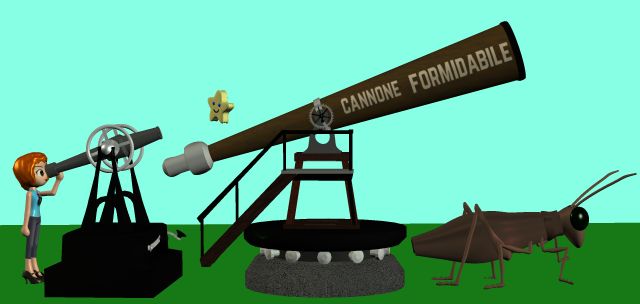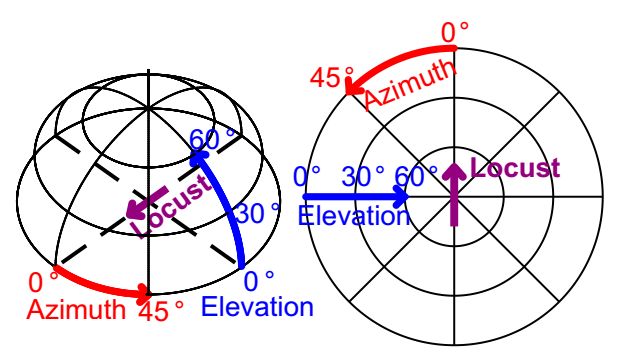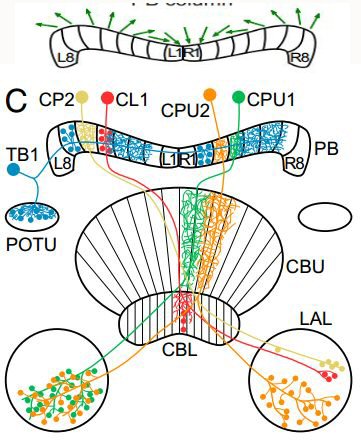Friday, October 02, 2020
Another amazing navigational sense
 These three things look similar. They have a deeper similarity in function. All three use altitude and azimuth to locate their targets.
Via PNAS, an analysis of how a locust uses the altitude and azimuth of polarized light, along with the actual location of the sun. [Paywalled article, and I paid.]
I haven't tried to digest the details, so I hope I'm getting the main point right!
Main point: The locust's eyes are doing double duty. Primarily they're performing the usual eye jobs, watching for food and obstacles and threats. Secondarily they're keeping track of the sun's position, and mapping the polarization of light in the whole sky. The polarized light is compared to an internal stored map to determine the insect's current position and orientation for flight and migration.
Mammals have a similar stored template map (for regular visible objects, not polarization), running around the hippocampus on the bottom edge of the cortex. The map is basically a 'reference horizon', and it's constantly updated to represent our current local horizon. Because we don't fly, we only need the azimuth. Flying insects need a 3d stored map, which is calculated by azimuth and altitude.
These three things look similar. They have a deeper similarity in function. All three use altitude and azimuth to locate their targets.
Via PNAS, an analysis of how a locust uses the altitude and azimuth of polarized light, along with the actual location of the sun. [Paywalled article, and I paid.]
I haven't tried to digest the details, so I hope I'm getting the main point right!
Main point: The locust's eyes are doing double duty. Primarily they're performing the usual eye jobs, watching for food and obstacles and threats. Secondarily they're keeping track of the sun's position, and mapping the polarization of light in the whole sky. The polarized light is compared to an internal stored map to determine the insect's current position and orientation for flight and migration.
Mammals have a similar stored template map (for regular visible objects, not polarization), running around the hippocampus on the bottom edge of the cortex. The map is basically a 'reference horizon', and it's constantly updated to represent our current local horizon. Because we don't fly, we only need the azimuth. Flying insects need a 3d stored map, which is calculated by azimuth and altitude.
 Some neurons are specifically tuned to memorized polarization patterns:
Some neurons are specifically tuned to memorized polarization patterns:
 8 is an interesting number for a keyboard, isn't it? Also an interesting number for a compass rose.
8 is an interesting number for a keyboard, isn't it? Also an interesting number for a compass rose.
 These three things look similar. They have a deeper similarity in function. All three use altitude and azimuth to locate their targets.
Via PNAS, an analysis of how a locust uses the altitude and azimuth of polarized light, along with the actual location of the sun. [Paywalled article, and I paid.]
I haven't tried to digest the details, so I hope I'm getting the main point right!
Main point: The locust's eyes are doing double duty. Primarily they're performing the usual eye jobs, watching for food and obstacles and threats. Secondarily they're keeping track of the sun's position, and mapping the polarization of light in the whole sky. The polarized light is compared to an internal stored map to determine the insect's current position and orientation for flight and migration.
Mammals have a similar stored template map (for regular visible objects, not polarization), running around the hippocampus on the bottom edge of the cortex. The map is basically a 'reference horizon', and it's constantly updated to represent our current local horizon. Because we don't fly, we only need the azimuth. Flying insects need a 3d stored map, which is calculated by azimuth and altitude.
These three things look similar. They have a deeper similarity in function. All three use altitude and azimuth to locate their targets.
Via PNAS, an analysis of how a locust uses the altitude and azimuth of polarized light, along with the actual location of the sun. [Paywalled article, and I paid.]
I haven't tried to digest the details, so I hope I'm getting the main point right!
Main point: The locust's eyes are doing double duty. Primarily they're performing the usual eye jobs, watching for food and obstacles and threats. Secondarily they're keeping track of the sun's position, and mapping the polarization of light in the whole sky. The polarized light is compared to an internal stored map to determine the insect's current position and orientation for flight and migration.
Mammals have a similar stored template map (for regular visible objects, not polarization), running around the hippocampus on the bottom edge of the cortex. The map is basically a 'reference horizon', and it's constantly updated to represent our current local horizon. Because we don't fly, we only need the azimuth. Flying insects need a 3d stored map, which is calculated by azimuth and altitude.
 Some neurons are specifically tuned to memorized polarization patterns:
Some neurons are specifically tuned to memorized polarization patterns:
We show here that certain neurons in the protocerebral bridge of the brain of the desert locust encode particular sun positions by responding best to a pattern of polarization generated by those sun positions.These 'keys' are on a 'keyboard' with 8 keys for the left eye and 8 keys for the right eye:
 8 is an interesting number for a keyboard, isn't it? Also an interesting number for a compass rose.
8 is an interesting number for a keyboard, isn't it? Also an interesting number for a compass rose.Labels: Grand Blueprint
